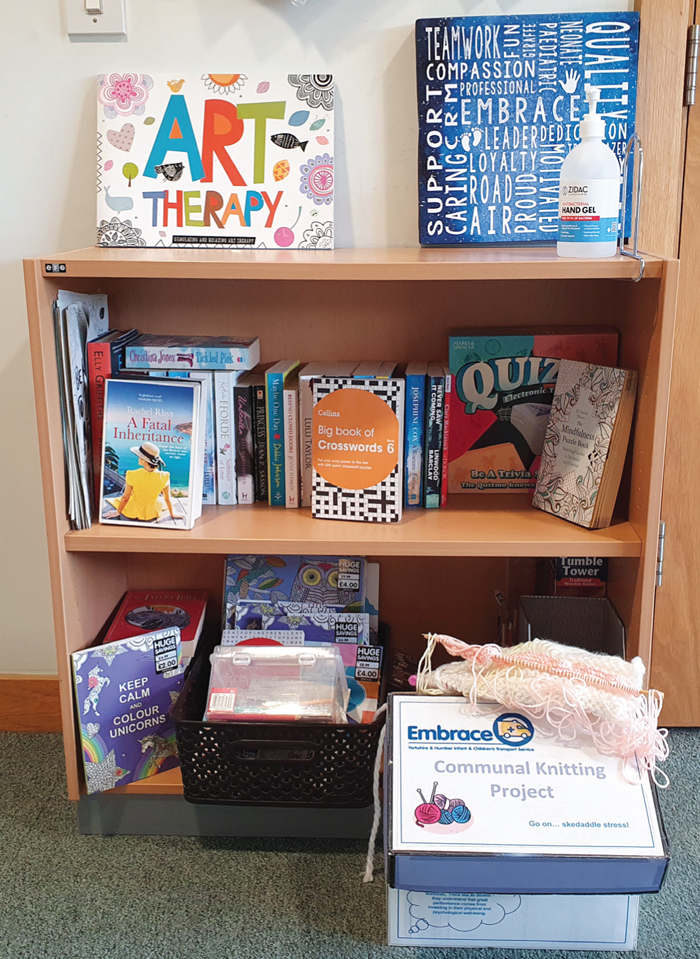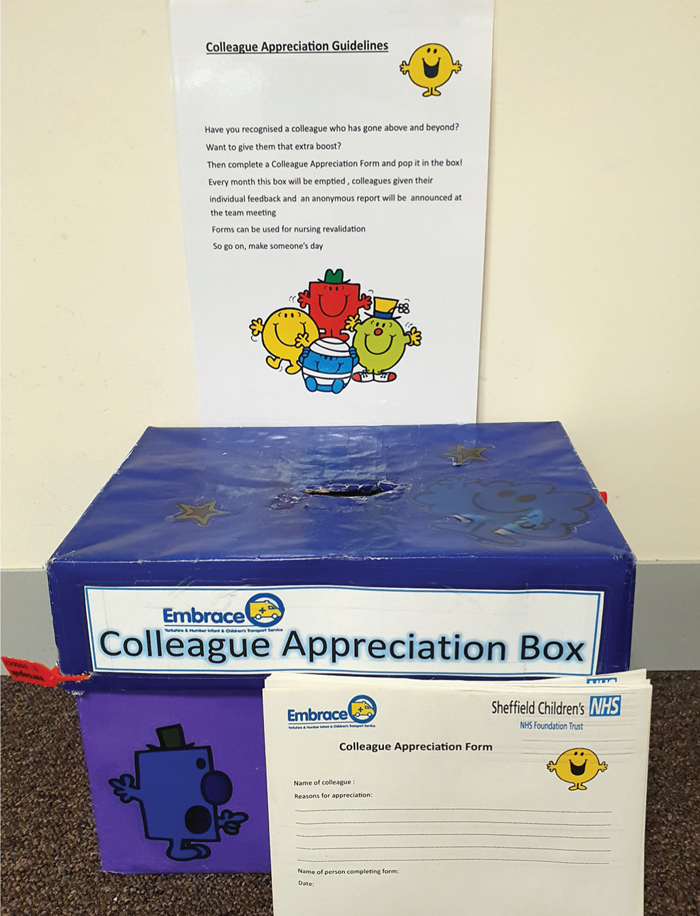Embrace: supporting the health and wellbeing of our staff
Embrace is a busy paediatric and neonatal transport service for Yorkshire and the Humber. Our activity is constant due to the wide range of patients we move, totalling over 2,200 transfers per year with a mix of intensive care transfers and repatriations. Evidence is emerging about the effects on staff mental health and coping abilities in an intensive care environment1 and over the last few years we have focused on the mental and physical wellbeing of our staff. This article describes the measures we have put in place at Embrace to support health and wellbeing in our work place.
Rose Kent
Advanced Nurse Practitioner, rose.kent1@nhs.net
Cath Harrison
Lead Consultant (Neonatal), cath.harrison@nhs.net
Embrace Yorkshire and Humber Infant and Children’s Transport Service, Sheffield Children's NHS Foundation Trust
Background
Deteriorating staff welfare leading to worsening patient outcomes has been described for many years,2 however, more recent research suggests a clear relationship between employee wellbeing and organisational performance.3
People tend to perform better and be happier at their place of work if they are in a safe and healthy environment. Staff recruitment and retention can be problematic in high intensity specialties and working towards better workplace environments can help with this. Furthermore, working conditions that are safer will reduce the risk of accidents and improve patient safety.4
Embrace started a health and wellbeing group in 2013 with an aim to mitigate the potential effects of a stressful workload. This group and the strategies implemented have developed further with the COVID-19 pandemic and the heightened need to support frontline NHS workers. A positive effect of the COVID-19 experience is the long-awaited acknowledgement of the impor-tance of the health and wellbeing of carers.
The importance of health and wellbeing
The intensive care unit environment is full of stressful situations for healthcare professionals and ‘burnout’ is not uncommon.5 Critical care nurses, in particular, are vulnerable to developing burnout due to the chronic occupational stressors they are exposed to, including:6
- high levels of responsibility
- working with advanced technology
- high patient acuity – patients require a high level of medical and nursing involvement, often 1:1
- caring for families in crisis
- having to make ethically challenging decisions
- involvement in morally distressing situations, particularly life-prolonging procedures that some may feel are unnecessary
- conflicts and the potential for difficult conversations with families
- coordinating care across specialties.
To provide safe, sustainable, patient-centred care, the NHS is critically dependent on a healthy and engaged workforce with good mental and physical wellbeing.7
Strategies for protecting health and wellbeing
Many systems have been developed to help health workers address and manage stress, some look at individual methodologies and others take a team approach. Yu suggests that mindfulness and compassion can decrease stress in healthcare workers.8 He describes meditation using the STOP sign – Stop, Take a breath, Observe and Priority first – to be used when dealing with an emergency. The SOAL approach – Stop, Observe, Accept, and Let go – can be used when there is emotional distress. These methods describe how mindfulness can change our approach from empathy to compassion and how this will help to counteract the ‘empathy fatigue’ seen in healthcare workers.8 Simulation and training have been used to improve coping mechanisms and have been shown to improve the healthcare worker’s perception of safety and preparedness while caring for patients in viral epidemics.9
Buchanan and Reilly looked at introducing HeartMath techniques to reduce stress and improve resiliency in healthcare providers.10 Study participants had to complete a ‘personal and organisational quality assessment-revised 4 scale’ before the start of training and again 4-6 weeks after training. The participants use a biofeedback application and sensor looking at heart rate variability alongside self-regulation techniques. Significant improvements were found in organisational stress, emotional stress and physical stress, and overall a positive impact on employee health, wellbeing and performance.
The military introduced the TRiM (Trauma Risk Management) system, which is a trauma-focused peer support system designed to help people who have experienced a traumatic, or potentially traumatic, event. The model is based on ‘watchful waiting’; monitoring individuals who have been exposed to a traumatic event, regardless of whether they were directly involved or involved from afar. This system is now being used in medical settings, particularly in critical care settings, following on from success in the armed forces. Courses are available to medical teams to train staff to detect workplace stress and to provide support and mentoring (starting from approximately £700).11
Strategies introduced at Embrace
Many of these strategies involve financial investment and signif-icant time, commitment and training for facilitators. We sought to introduce low-cost options and so we initially established a health and wellbeing group that included staff from all disciplines to promote different ideas and views. We have meetings every other month and we set up small working groups to allow projects to be seen through to completion. Both physical and mental wellbeing strategies are included. All meetings are open so all staff can use this forum to voice concerns or bring ideas to the table.
Interventions are aligned with the categories of Five Ways to Well Being:12
- connect with other people
- be physically active
- learn new skills
- give to others
- pay attention to the present moment.
The following list highlights the initiatives we have introduced at Embrace to promote health and wellbeing:
Macmillan bake-off
The team has been enthusiastic about baking and raising money for charities as well as engaging with the world outside of the hospital. There is always some healthy in-house competition about what has been made.
Library
Initially set up to provide an opportunity to share books, this has recently progressed to a book club.
Wellbeing box
This includes colouring books and pens, games and even a team knitting item, eg a scarf that anyone can contribute to.
Snack packs
These have been introduced and are available for all staff for those vulnerable times when you need a pick-me-up.
Fruity Friday
To promote healthy eating a hamper of fresh fruit is bought once a month for staff to share.
Debrief book
A diary is used to write in the names of staff involved in difficult or traumatic referrals/transfers. Staff will be contacted (either face-to-face, via a phone call or a text message) at 24 hours and at one week to check they are alright. Further support is arranged if required. This includes the call handlers and drivers as we are mindful that everyone can be affected. Charitable funds have been used to provide training for our call handling team by the Samaritans. The training gives strategies for handling difficult phone calls and, importantly, ways to cope emotionally after the event.
Transport risk scoring
Each transport activity is risk-assessed prior to departure. This includes length of personnel experience at Embrace, staff fatigue, adverse weather conditions and a self-assessment of own health or wellbeing. If the risk score highlights a problem, we address this by, for example, changing personnel, allowing rest times, etc. This ensures that the transfer is as safe and effective as possible.
 Embrace’s library with colouring books, games and a team knitting project.
Embrace’s library with colouring books, games and a team knitting project.
Shift lengths
It was noted that staff often left work well after their appointed time due to the geographical coverage of the service offered by Embrace. Rendezvous points have been devised to ensure staff are relieved at the earliest possibility. These are risk-assessed safe areas such as service stations and ambulance stations where the current team can be replaced by a team that has more recently commenced shift. Following introduction of the Working Time Regulations13 and the European Working Time Directive,14 11-hour rest periods between shifts are actively encouraged. It is vitally important that staff have adequate rest between consecutive shifts. This is especially true for those staff that have a long commute to work, which erodes into this time.
Rest breaks
During quieter shifts, staff are supported in taking time out to walk within the local area. The provision of a picnic bench outside of the work environment has been a welcome escape. Staff are encouraged to ask for ‘time out’, as it is important for staff to feel comfortable to speak out and take time to recharge. Team meal times are encouraged; having a weekend ‘chip shop run’ is a wel-come treat and brings the team together in a sociable gathering.
Feedback
Positive feedback is vital in ensuring staff feel valued as team members. We constructed a staff appreciation box, which enables us to nominate a member of staff at any time. Forms are simply completed and individual letters sent to the nominated staff, detailing why they have been selected along with congratulations.
COVID-19 developments
We have found, like everywhere else in the NHS during the pandemic, that the health and wellbeing of our staff has become even more important. Activity has changed, routine practices have changed and added stresses have become apparent.
As well as continuing our usual wellbeing strategies, we have developed a COVID free area known as the ‘NOVID’ room. This room is away from the clinical areas, with resources to help staff have a well-deserved break and recharge. Pre-COVID, it was not uncommon for hospital canteens to be abandoned in favour of staff rooms where there is no release from clinical conversations during break time. We have faced challenges with distancing to try and keep a separate space for ‘down time’ but, with support from the whole team, an area has been created to allow this. Staff are encouraged to take breaks and meal times in here.
Additional support from our trust has provided psychology sessions allowing one-to-one sessions and team support, which have been invaluable.
 The colleague appreciation box.
The colleague appreciation box.
Summary
Staff health and wellbeing is critical to clinical service delivery and quality of care.
With the described introductions to our service we have improved the work environment for the team with minimal cost. Feedback from the team has been overwhelmingly positive in terms of morale and team cohesiveness. Regular group meetings led by the health and wellbeing lead ensure ongoing review, development of new ideas and the ability to maintain momentum for new projects.
The support of management is essential in introducing change but what is most important is the acceptance of the team and talking to each other to encourage positive mental health. By working together we can deliver new ways to protect and enhance our physical and mental wellbeing.
Or read this article in our
Tablet/iPad edition


